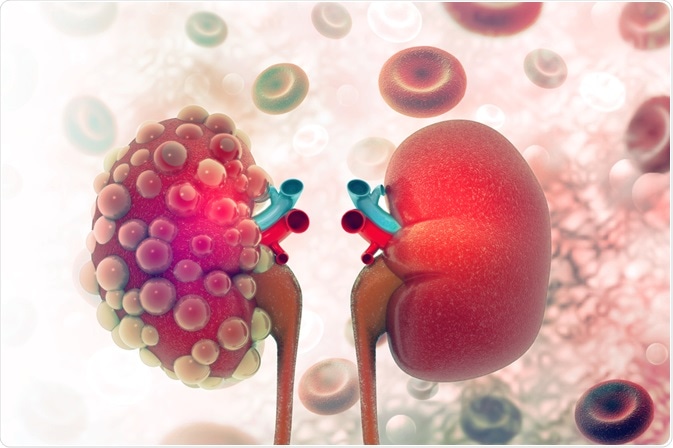Wilms Tumor is the most common type of kidney cancer in children, although it can also affect some adults. In the majority of cases, the tumor is localized to the kidney and has not formed metastases in other parts of the body at diagnosis, which is favorable for the prognosis.

Image Credit: crystal light / Shutterstock.com
Affected area
The vast majority of nephroblastomas are unilateral, with disease in a single kidney accounting for 95% percent of all cases. These are usually encapsulated and often present as a single tumor.
A small number of people with Wilms tumor are associated with metastasis to other parts of the body. The most common location for this to occur is the lung, where it causes specific symptoms that are related to this area of the body.
If the tumor ruptures, the patient is at risk of hemorrhage and peritoneal dissemination of the tumor, which usually requires immediate surgical intervention. There are three main elements of a Wilms tumor found in the kidney, which include blastema, mesenchyme and epithelium.
Associated conditions
The majority of children that suffer from Wilms tumor are otherwise healthy and do not have any other notable health conditions. However, approximately 1 in 10 of all cases are associated with malformations that may increase the risk of tumor development.
Overgrowth syndromes may lead to Wilms tumor with symptoms of excessive somatic growth leading to macroglossia, nephromegaly and hemihypertrophy. Some examples of the health conditions that are related to overgrowth include Beckwith-Wiedemann syndrome, Perlman syndrome, Sotos’ syndrome and Simpson-Golabi-Behmel syndrome.
Other conditions that may be linked to Wilms tumor but do not display characteristics of overgrowth include Bloom’s syndrome and Denys-Drash syndrome.
Familial or sporadic
Although the majority of Wilms tumor cases do not appear to have a genetic link, some families have been identified to be at an increased risk of the disease due to a hereditary factor.
Gene mutations are usually passed on in an autosomal dominant pattern as a result of one of several currently known mutations, such as:
- Mutation of chromosome 11 of the WT1 gene, which is responsible for the encoding the protein to down-regulate the growth factor IGF-11.
- Mutation of chromosome 11 of the WT2 gene.
- Mutation of chromosome 16 or 1p on WT3 gene.
Symptoms
As most Wilms tumors are localized to the kidneys and often on one side, symptoms may take some time to emerge and are usually associated with this area of the body.
Abdominal pain and swelling is common, particularly when the tumor grows to a considerable size and obstructs the body tissues. Urine discoloration may also be evident due to the effects of the tumor.
More generalized symptoms, such as fever, nausea, vomiting and diarrhea, may also present. This often leads to a loss of appetite and a general feeling of malaise. Hypertension is also an indicative symptom of the disease, which presents due to the malfunction of the kidney and renal system associated with the tumor.
Categorization by prognosis
The prognosis of Wilms tumor depends on the type of cells present and whether they display anaplastic characteristics. Anaplasia refers to cell defects with large and distorted DNA in the cell nucleus, which is associated with a more aggressive disease and poorer prognosis.
Wilms tumor without anaplasia is termed favorable, as it tends to be managed more effectively and has a higher cure rate.
References
Further Reading